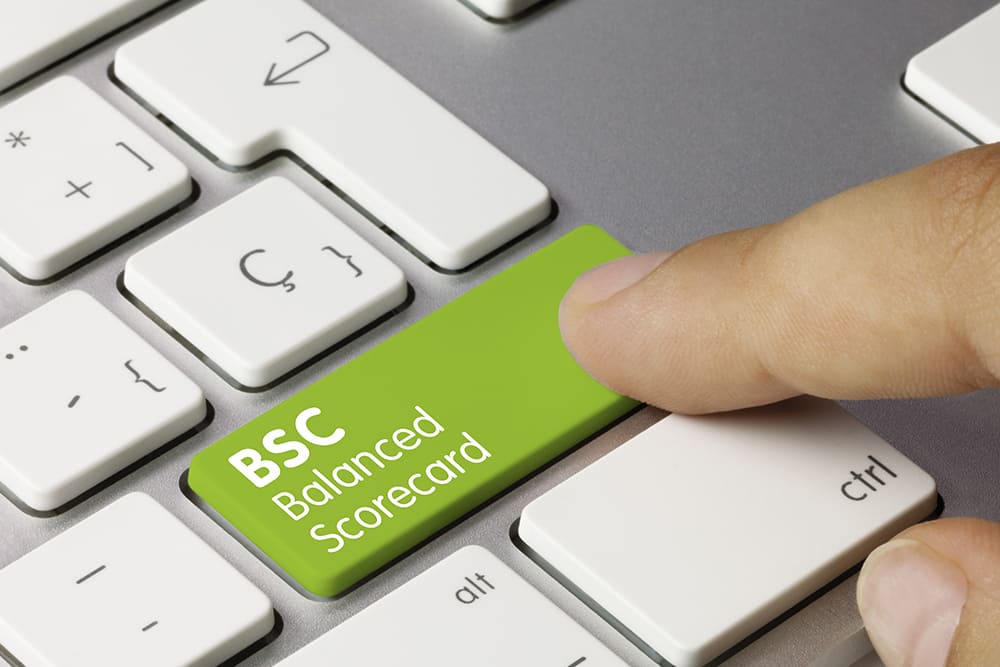How to Use a Balanced Scorecard
2 July 2021
Every organization needs a way to identify, manage and measure its strategic objectives. One such tool is the Balanced Scorecard (BSC). It is a performance management tool that helps define strategy and then deliver it by identifying action plans. It also helps organizations to monitor the company’s progress toward achieving strategic outcomes by tracking Key Performance Indicators (KPIs).

What are the elements of the Balanced Scorecard?
The BSC is a simple strategic performance management framework that was originally introduced by Robert Kaplan and David Norton. The popularity of the tool remains high and it has several benefits for organizations, although many organizations still don’t use it effectively.
The first component of a Balanced Scorecard is the Strategy Map. The Strategy Map is the most important part of the Balanced Scorecard and it lists all your strategic goals on one page representing the four different perspectives critical to business success: customer, finance, internal business processes and learning and growth.
The customer perspective outlines the objectives regarding what you need to deliver to your customers and markets if you are going to achieve your financial objectives. Of course, growing revenue and profit are often primary objectives in the financial perspective, but this area also could include cost savings and efficiencies. The internal process perspective considers what processes need to be in place and what processes you have to be best at in order to achieve your customer- and finance-related objectives. The learning and growth perspective is concerned with more intangible drivers of performance including goals in relation to your human capital, information capital and organizational capital.
You can—and should—modify these four perspectives to fit your organization. Some companies might have three perspectives, while others might add a fifth perspective to highlight an additional area of performance that’s important to their business (i.e., a public sector organization might want to add a perspective for the community). Companies can tweak the names and perspectives of the Balanced Scorecard to suit the needs of their organization.
The second component of the Balanced Scorecard is the Action Plans that ensure the proper programs and initiatives are in place to achieve the strategic objectives.
KPIs are the third element of a Balanced Scorecard. KPIs allow companies to measure and monitor progress against the strategic objectives that are outlined in the Strategy Map.
How is the Balanced Scorecard used?
When used properly the Balanced Scorecard can transform organizations in several ways.
- Communicate strategic goals
The Balanced Scorecard makes communicating your strategy internally and externally much easier. The simplicity of the strategy map where you visualize all your goals on a single page makes goals easy to understand for even those who weren’t involved in creating the strategy.
- Gain buy-in across the organization
If the Balanced Scorecard is developed in a way that involved everyone in the organization and used to communicate the goals in line with the company mission and vision, this helps to create understanding and buy-in for your strategic goals across the organization.
- Align the organization behind strategic goals
The perspectives of the strategy map cover the different departments of an organization including finance, marketing, operations, human resources, IT, and more. This creates alignment of goals across the entire origination and outlines how goals in different departments support each other to deliver success across the entire organization.
- Monitor all activity
Beyond the alignment and strategic focus, it helps you to address all the activities you have in your organization. Lots of organizations run projects, programs and activities that aren’t aligned with strategic goals. When you have a Balanced Scorecard in place you can make sure all of your activities, across all different departments of the organization, are aligned with the strategic goals. This results in a tighter focus and makes sure the strategy gets translated into action.
- Develop KPIs/metrics to track progress
The Balanced Scorecard also includes the critical KPIs that need to be monitored to track progress against your organization’s strategic goals.
- Report internally and externally
Your Balanced Scorecard also serves as a helpful reporting framework to communicate your organization’s progress on strategic goals. You can use the strategy map and KPIs to create intuitive dashboards in order to present the right information, in the right way, to the right people.
It is estimated that more than half of all companies in the U.S., Europe and Asia are using the Balanced Scorecard to define, track and report on strategic objectives. In fact, a global study by Bain & Co found the Balanced Scorecard is one of the top 10 most widely used management tools in the world.
Where to go from here
If you would like to know more about , check out my articles on:
- 7 Benefits of a Balanced Scorecard
- The Four Perspectives in a Balanced Scorecard
- What Is A Balanced Scorecard? A Quick Overview
- Balanced Scorecard: An Overview
Or browse the Strategy & Business Performance to find the metrics that matter most to you.
Related Articles
20 Generative AI Tools For Creating Synthetic Data
The AI revolution that we’re currently living through is a direct result of the explosion in the amount of data that’s available to be mined and analyzed for insights.[...]
How To Tell Reality From Fiction Amid The AI-Driven Truth Crisis
The artificial intelligence narrative swings between utopian dreams and dystopian nightmares, often overshadowing the nuanced reality of its current capabilities and limitations.[...]
7 Ways To Turn The ‘Bring Your Own AI’ Threat Into An Opportunity
As AI tools become increasingly accessible, companies face a new trend: BYOAI, or bring your own AI.[...]
AI Gone Wild: How Grok-2 Is Pushing The Boundaries Of Ethics And Innovation
As AI continues to evolve at breakneck speed, Elon Musk's latest creation, Grok-2, is making waves in the tech world.[...]
Apple’s New AI Revolution: Why ‘Apple Intelligence’ Could Change Everything
Apple's announcement of 'Apple Intelligence' marks a seismic shift in how we interact with our devices.[...]
Why AI Models Are Collapsing And What It Means For The Future Of Technology
Artificial intelligence has revolutionized everything from customer service to content creation, giving us tools like ChatGPT and Google Gemini, which can generate human-like text or images with remarkable accuracy.[...]
Sign up to Stay in Touch!
Bernard Marr is a world-renowned futurist, influencer and thought leader in the fields of business and technology, with a passion for using technology for the good of humanity.
He is a best-selling author of over 20 books, writes a regular column for Forbes and advises and coaches many of the world’s best-known organisations.
He has a combined following of 4 million people across his social media channels and newsletters and was ranked by LinkedIn as one of the top 5 business influencers in the world.
Bernard’s latest book is ‘Generative AI in Practice’.










Social Media